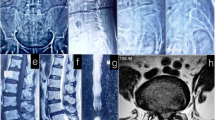Abstract
Background
Lumbar fusion with rigid fixation can be complicated by adjacent segment degeneration, which may cause neurological deficits and back pain, and occasionally necessitates revision surgery. This type of revision surgery is difficult to perform in a minimally invasive manner because it requires the revision of the original internal fixation instruments.
Method
We describe a biportal endoscopic spinal surgery (BESS) procedure for revision surgery due to adjacent segment disease after lumbar fusion with rigid fixation instruments. The radiological images and complete surgical procedure are presented.
Conclusions
BESS effectively enabled nerve decompression, intervertebral fusion, and revision of lumbar fusion with fixation instruments in a minimally invasive manner.






Similar content being viewed by others
References
Adogwa O, Parker SL, Mendenhall SK (2013) Laminectomy and extension of instrumented fusion improves 2-year pain, disability, and quality of life in patients with adjacent segment disease: defining the long-term effectiveness of surgery. World Neurosurg 80(6):893–896. https://doi.org/10.1016/j.wneu.2011.12.082
Harrop JS, Youssef JA, Maltenfort M (2008) Lumbar adjacent segment degeneration and disease after arthrodesis and total disc arthroplasty. Spine (Phila Pa 1976) 33(15):1701–7. https://doi.org/10.1097/brs.0b013e31817bb956
Helgeson MD, Bevevino AJ, Hilibrand AS (2013) Update on the evidence for adjacent segment degeneration and disease. Spine J 13(3):342–351. https://doi.org/10.1016/j.spinee.2012.12.009
Hilibrand AS, Robbins M (2004) Adjacent segment degeneration and adjacent segment disease: the consequences of spinal fusion? Spine J 4(6 Suppl):190S-194S. https://doi.org/10.1016/j.spinee.2004.07.007
Tan QC, Wang D, Yang Z (2021) Implant preservation versus implant replacement in revision surgery for adjacent segment disease after thoracolumbar instrumentation: a retrospective study of 43 patients. World Neurosurg 150:e511–e519. https://doi.org/10.1016/j.wneu.2021.03.046
Acknowledgements
We thank Medjaden Inc. for the scientific editing of this manuscript.
Funding
This work was supported by the Capital Health Research and Development of Special (SF No. 2022–2-6043).
Author information
Authors and Affiliations
Corresponding author
Ethics declarations
Ethics approval and consent to participate
This study protocol was approved by the Ethics Committee of Peking University Shougang Hospital (No. 2021ZZCX07) and adhered to the guidelines of the Declaration of Helsinki. Informed consent was obtained from all individual participants included in the study.
Conflict of interest
The authors declare no competing interests.
Additional information
Publisher's note
Springer Nature remains neutral with regard to jurisdictional claims in published maps and institutional affiliations.
Key points
1. It is necessary to determine whether ASD is combined with instability and whether the original surgical level is fused.
2. ASD with instability requires spinal fusion, and a revision surgery of the original fixation instruments may be inevitable.
3. We successfully performed a revision surgery for ASD with rigid fixation by using the BESS technique, which provides a minimally invasive option for treating this disease.
4. The internal fixation instruments can be removed under endoscopic observation by exchanging the viewing portal and working portal.
5. For revision surgery performed using the BESS technique, the original surgical site need not be exposed, and this can reduce the risk of blood loss and surgical-site infection.
6. BESS has wide indications for decompression and fusion, and can be applied to a variety of ASDs.
7. A K-wire can be implanted through the quarterback incision to retract the dural sac and increase the efficiency of intervertebral space preparation.
8. The BESS technique can be used for a variety of complex spinal operations due to the separation of its viewing portal and working portal.
9. Owing to decreased surgical trauma to the back muscles and soft tissues, the postoperative back pain was mild, and the patient could achieve earlier postoperative ambulation.
This article is part of the Topical Collection on Spine degenerative
Supplementary Information
Below is the link to the electronic supplementary material.
Supplementary file1 (MP4 38025 KB)
Rights and permissions
About this article
Cite this article
Wang, W., Lyu, P. & Liu, Z. How I do it: biportal endoscopic spinal surgery for revision of adjacent segment disease after instrumented lumbar fusion. Acta Neurochir 164, 2337–2342 (2022). https://doi.org/10.1007/s00701-022-05318-3
Received:
Accepted:
Published:
Issue Date:
DOI: https://doi.org/10.1007/s00701-022-05318-3




